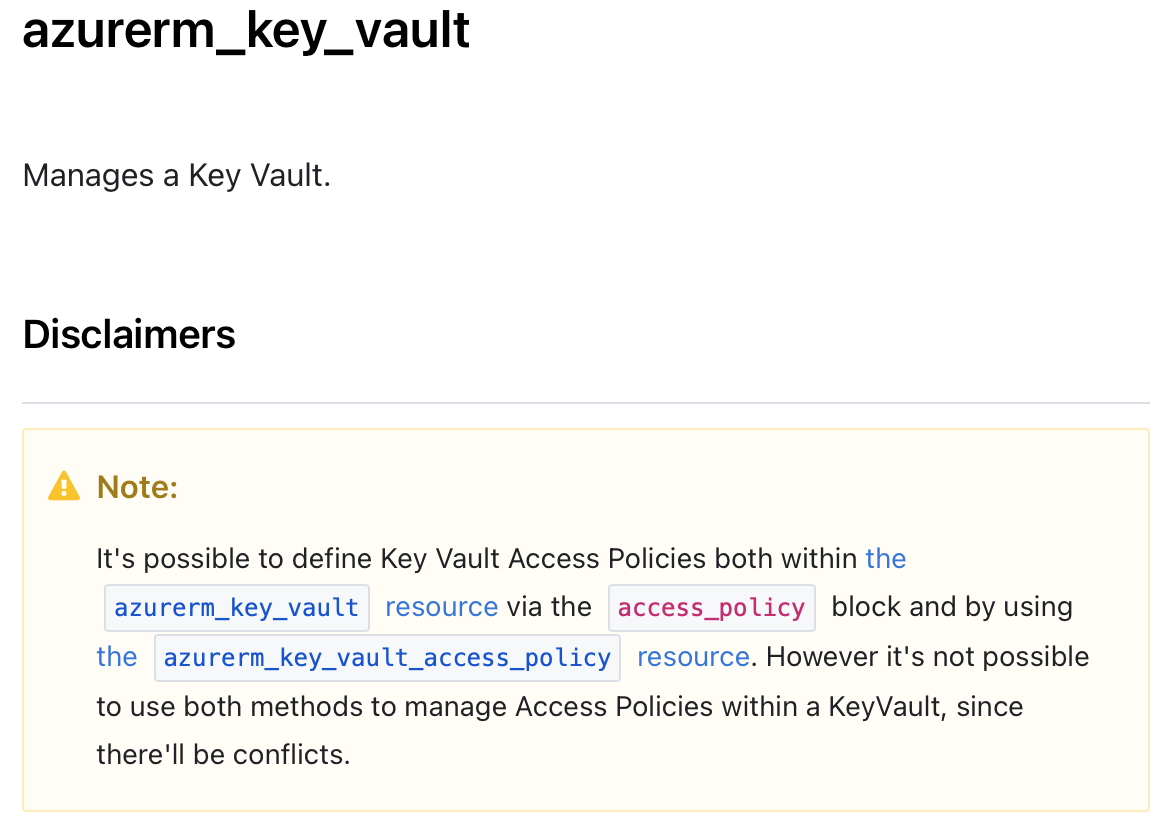Adventures of Key Vault in Terraform
Access Policy Resources vs Embedded Access Policy
There is 2 ways to manage access policies in Terraform when it comes to Key Vault. You either use azurerm_key_vault_access_policy or you use the “access_policy” block inside the azurerm_key_vault
These 2 methods conflict with each other when you try to use them both as per the warning at the top of the Key Vault Resource page.

Therein lies the problem
What if you need to use both though? Because you’re playing chicken and egg with your permissions.
My scenario probably isn’t an overly common one but I will explain.
Creating a Key Vault by default you would include the user who’s creating the resource as the default access policy using the data azurerm_client_config component. In my case this is my Pipeline Service Principal.
When creating a plan the data compenent is set to blank pending a change. While using the azurerm_key_vault_access_policy and not including an access_policy block in the my Key Vault creation what I found was that every now and then the access policy resource would error on my pipeline which meant my pipeline would no longer run as during the plan stage it needs access to the key that is created inside and with no access policy it was unable to refresh the state.
In addition to this I needed to use the resource instead of the block as I was adding access for a logic app that I was creating in code that was using the Key Vault resource and that had to be created after the Key Vault was created.
So how did I stop the permission dissapearing?
By no means am I saying that is the right or recommended solution, as often with these things it is simply a solution to a problem at the time.
I’ve put the code below where I am doing exactly what we are warned we cannot do. I’ve used the block to the data component so that the Pipeline Service Principal will not be removed and then I’ve created my logic app’s managed idenity as a seperate resource.
How I’ve got around this is by using lifecycle condition which essentially makes Terraform ignore if there is an update to the access policies. As I have said this is not right or recommended it is simply a workaround! Lifecycle Policies in Terraform
resource "azurerm_key_vault" "mgmt_keyvault" {
provider = azurerm.management
name = local.key_vault_name
location = azurerm_resource_group.managed_services_rg.location
resource_group_name = azurerm_resource_group.managed_services_rg.name
tags = local.logic_app_tags
enabled_for_disk_encryption = true
tenant_id = data.azurerm_client_config.current.tenant_id
purge_protection_enabled = var.purge_protection_enabled
soft_delete_retention_days = var.soft_delete_retention_days
sku_name = "standard"
access_policy {
tenant_id = data.azurerm_client_config.current.tenant_id
object_id = data.azurerm_client_config.current.object_id
secret_permissions = [
"Get",
"List",
"Set"
]
}
lifecycle {
ignore_changes = [
access_policy
]
}
}
resource "azurerm_key_vault_access_policy" "mgmt_keyvault" {
provider = azurerm.management
depends_on = [
azurerm_key_vault.mgmt_keyvault
]
key_vault_id = azurerm_key_vault.mgmt_keyvault.id
tenant_id = azurerm_logic_app_workflow.service_now.identity[0].tenant_id
object_id = azurerm_logic_app_workflow.service_now.identity[0].principal_id
secret_permissions = [
"Get",
"List"
]
}
